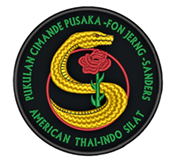 |
Pukulan Cimande Pusaka - Fon JerngYou can email any questions on the style, policies or products to: If you would like someone to call you please include your phone number. |
|||
| Silat Home - Introduction - History - Distance - Silat/Fon Jerng Store - Rank | ||||
The Tepak Selancar Tarian of Tarik Kolotby Pendekar Sanders Most of the old West Javanese Pencak Silat styles incorporated stylized "dances" within their structure. Often individuals have traveled to Indonesia to study but have not remained long enough to understand the complete program. What often happens is the student only attempts to copy the obvious punching and kicking and discounts the Tarian as simply "dance". Typically these half trained students make claims such as we don't "dance" we just fight. In the Pencak Silat Cimande from Tarik Kolot, Cimande village in West Java that I teach we use the first original dance of Cimande as passed on from Embah Kahir, its originator. It is called "Selancar" and it is composed of the following components: 1. Lanka Ampat (four steps or movements) 2. Bangau (crane mannerisms) 3. Meong Lugan (the awakening tiger ) 4. Luk Paku (carrying on the back) 5. Pesek (Kupas) Roay (plucking leaves and opening peanut pods, this is the monyet or monkey) 6. Jalak Pengkor (the limping crow) They are performed on a figure of eight or six. Together they represent the essence of the selancar. Each component teaches combative realities and greatly strengthens the physical structure, including balance for combat. For example Lanka Ampat operates from an extremely wide stance, suddenly requiring the player to spring up into a one legged stance. Tremendous leg strength is developed for sweeps and kicks and balance is improved as well. The hand positions and the arm movements develop the entire mind and body for the crane mannerisms in fighting. Abandoning Lanka Ampat and going directly to the combative crane techniques will deprive the player of the strength and balance necessary to move effectively in their use. In addition as mentioned the hand positions and arm movements prepare one for powerful strikes and hit parries. In addition the music that is always used while the selancar is being practiced adds an internal dimension that prepares the student mentally to access the crane "essence" or the Ilmu of Silat if you will. Done on two touching circles (hence the figure of eight) this symbolically takes the student from the external to the internal and back as one side represents the physical here and now and the other the future, the unknown, the outside and the inside etc. Other mystical concepts are revealed to the practitioner who travels the eight. Form and function often exist as silent partners. These arts should not be dissected with valuable parts discarded by the uninitiated without the full understanding of what they were removing. In this short article we have only discussed one of the components of the selancar and all are equally important and are used for a variety of combative preparedness. Added together the practitioner is transformed into something new which we call the Naga or King Snake Dragon. On a final note this Selancar, being the first original Tarian of Cimande, is also shared in the Sera of Embah Kahir, the originator of that Art.
|